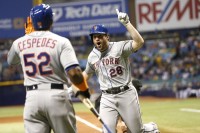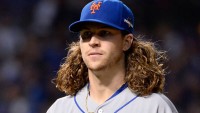
All winter long, Mets fans seemed strangely resolute that neither Noah Syndergaard or Jacob deGrom should cut their hair. Thor had some fun with the fans on the topic:
This offseason neither Thor nor deGrom chopped off their locks. It wouldn’t make sense. Why? As Archie Bunker would say, “The Bible. If you read it, you’d know.”
In the Bible story of Samson and Delilah (Judges 16), we learned that Samson’s great power was due to his hair. Once his hair was chopped, his power was gone. It would lead to his ultimate demise.
As major leaguers say, part of deGrom’s power comes from his hair. Apparently, hitters are having trouble picking up deGrom’s pitches because either they are distracted by his hair or because the hair temporarily hides the ball. With deGrom’s repertoire, the ability to hide the ball, however he does it, makes his pitches all the more dangerous.
I’m not sure if deGrom cutting his hair would lead to his demise. What I do know is that it’s not wise to tempt God. Please don’t cut your hair deGrom.
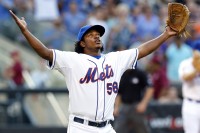
Jenrry Mejia three his entire career away for his continued use of PEDs. At the age of 26, his career is over. It really makes no sense whatsoever.
In an earlier MMO article, different avenues were examined as to the reason why Mejia tested for PED use a third time despite his professed innocence. As part of the analysis, there was the mention of a Latino Sports article wherein Mejia claims he was being that no one was helping him. He said the player’s union abandoned him. He was told that if he appealed the second positive test baseball would suspend him a third time thereby giving Mejia a lifetime suspension.
Mejia has now double-downed on those claims in an exclusive interview with Ben Berkon of the New York Times:
Mejia said that baseball officials told him that if he appealed the punishment for the second doping offense, “they will find a way to find a third positive,” Mejia said through an interpreter. “I felt there was a conspiracy against me. I felt that they were trying to find something to bring me down in my career.”
Naturally, MLB denies these claims.
As for Mejia, who never appealed any of his three steroid suspensions, he will tell anyone who is listening that no one was there to help him save his career:
The association should have done more, Mejia said, adding that he thought the union “should have been there to defend me – because that’s what they’re there for. They should have found something to appeal for.”
It’s interesting that Mejia would continue to profess his innocence while doing nothing to clear his name or toss aside the lifetime suspension. In the NFL, Tom Brady destroyed evidence and took the NFL to court over four games. For his part, Mejia will cry to anyone who will listen.
Overall, while it’s hard to fathom how anyone could have three positive PED tests so close in time, it’s getting harder to fathom how Mejia is the victim of some elaborate conspiracy theory. As more and more times passes, Mejia has substituted actions for words.
Just like Mel Gibson, Flores is certain there’s a Conspiracy Theory. Sooner or later, he’s going to have to settle which one he’s sticking with. Hopefully, like Mel Gibson in the movie, Mejia just disappears forever.

When we talk about the Mets locking up their young pitching, the general consensus is Jacob deGrom is the person most likely to sign an extension before he hits free agency.
For his part, deGrom has said he is open to an extension. He is the oldest pitcher of the group. His agent isn’t Scott Boras. He’s not a local kid who grew up rooting for the Yankees. deGrom seems more affable than a Matt Harvey, so most assume he will re-sign with the Mets at a somewhat discounted rate. Well, today that notion flew out the window:
Statement from Brodie Van Wagenen, Jacob deGrom's agent. pic.twitter.com/6ARbCyaUeb
— Marc Carig (@MarcCarig) March 4, 2016
Let’s not overstate the meaning of this. deGrom thought he was worth more than the $607,500 he is going to be paid next year. He wasn’t going to agree to it, but under the Collective Bargaining Agreement, he had no recourse but to not sign the deal. As is their right, the Mets accepted deGrom’s decision and then told him he was going to be paid that amount whether he liked it or not.
This is not a strain in the relationship between deGrom and the Mets. The only thing that can be gleaned from this is deGrom is not willing to sign an under-value market contract. So what is his market?
The Mets will not have to pay deGrom next year until he hits arbitration as a Super Two player. Judging from Harvey’s first year of arbitration, he will be slated to receive around $4.325 million. If deGrom fights for much more than that, we will all know the type of fight the Mets will have when deGrom gets closer to free agency.
As it stands, deGrom will become a free agent two years after Harvey. When Harvey does become a free agent, it will be around the time the Mets could begin talks with deGrom on an extension to buy out his remaining years of arbitration and a couple of years of his free agency.
When deGrom does hit free agency, he will be 32 years old. If he signs two years prior to free agency, he will be 30 years old. We saw this offseason that 30 year old pitchers can receive massive free agent deals. David Price just signed a 7 year $217 million contract with an opt out after three years. For his part, Zack Greinke, 32, signed a six year $206 million contract. These two pitchers are being paid between $30 – $35 million per year.
Now, deGrom doesn’t have Price’s or Greinke’s credentials . . . yet. deGrom won the Rookie of the Year award in 2014. He was the star at the All Star Game in 2015. He finished Top 10 in Cy Young voting. He had a historic start to the postseason out-dueling Clayton Kershaw in Game One. He then beat the aforementioned Greinke in Game Five. If deGrom continues on this path, he will certainly be worth something in the ballpark of $30 million per year. deGrom’s actions today certainly points to him not wanting anything less than what he thinks he is worth.
Now, on an extension, the Mets can manipulate how much deGrom earns when and try to give him deferred money. However, it is fair to assume deGrom could command close to an average annual value of $30 million per year. As it stands, it appears the Mets will have between $35.5 – $49.5 million to spend on pitching and a bench.
Therefore, as it stands, if deGrom is going to insist on an extension at what he perceives as his value, as is his right, the Mets will have to expand the payroll beyond $140 million to lock up their pitching.
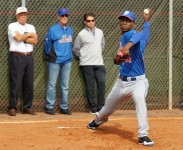
There was a point in time that Rafael Montero was a well regarded prospect. He was once going to force Jacob deGrom into a bullpen role. Now, the only thing we know is the Mets can’t rely upon him right now.
In many ways, 2016 is going to be a make or break year for Montero. Somewhat unfairly the organization turned sour on him last year. He went on the DL in April with shoulder tightness. He was found to have rotator cuff inflammation, which effectively ended his year. In August, he tried to rehab the injury and make some minor league starts, but he again had to be shut down.
This year, Terry Collins wants to challenge Montero as the Mets believe there was really nothing wrong with Montero. Symbolically, the Mets let Montero make the first start in Spring Training on the road against the Nationals.
It didn’t go well. Montero threw 39 pitches in only one inning. He walked four, gave up two hits, and allowed two runs. Not the best of starts. It’s not how he wanted the Spring with the Mets challenging him to be better this year.
At the end of the day, one start shouldn’t mean much. He can go out the rest of Spring Training and pitch very well. He could begin the year in AAA and pitch very well. He could become an injury replacement or spot starter in the rotatio. He could join the bullpen during the year.
There will be opportunities for someone. However, that someone is increasingly becoming someone other than Montero. Last year, Montero was surpassed by Sean Gilmartin and Logan Verrett. They’re likely going to get the first call for spot starts or bullpen work assuming they don’t make come north with the club.
Putting that aside, what was more troubling for Montero was the work of Gabriel Ynoa. He came into the game right after Montero flopped. He threw three scoreless innings and impressed Terry Collins:
Terry Collins says he was very impressed with Gabriel Ynoa today. pic.twitter.com/mSTNgVOFTo
— New York Mets (@Mets) March 3, 2016
Ynoa is a well regarded prospect. He’s ticketed for AAA this year. If yesterday is any indication, it appears that Ynoa is inching past Montero if he hasn’t done so already. While we shouldn’t put too much stock into one Spring Training game, the results today were important. The Mets wanted to challenge Montero to rise to the occasion. Instead, the Mets walked away being impressed with Ynoa.
The problem wasn’t that Montero had a rough outing. The problem is that yet again another Mets pitcher took advantage of an opportunity given to them that was preceded by a Montero failure.
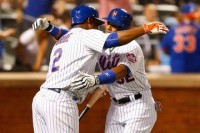
It’s fortunate that the Cleveland Indians Spring Training facility is in Goodyear, Arizona because Yoenis Cespedes seemingly has it out for Juan Uribe:
https://twitter.com/nypost_mets/status/705582411531362305
It’s hilarious that Cespedes would name a pig that’s a champion and name him Uribe. I can think of no more fitting tribute for Uribe. The man has been a part of multiple World Series winning teams, and we saw last year he has the heart of the champion. We also saw over the course of his career that there’s a little more of Uribe to love.
Cespedes naming his pig Uribe shows how much the Mets players loved and respected not just Uribe but each other. It shows that the Mets will miss Uribe, Kelly Johnson, Daniel Murphy, and Michael Cuddyer. That speaks volume not just about those players, but also this team.
Fortunately, a strong clubhouse remains. It’s going to welcome these new players, and they’re going to continue to be a strong tight-knit team that will hit the ground running once the 2016 season officially begins.
I love this team.
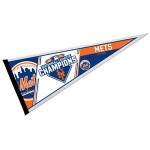
As the Mets have begun playing Spring Training games, they have begun their defense of the National League pennant and have their sights on the World Series. Part of the run of any pennant is seeing how far your team has come. We know the 2015 roster and lineup changes dramatically from Opening Day.
Each Mets team that has won a pennant has had a different ride featuring different players who were there from the beginning. Can you name the players in the Opening Day lineup each year the Mets won the pennant? Good luck.
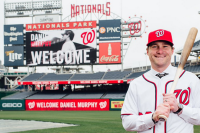
In about one hour, the Mets will play their first Spring Training game of the season. It also marks the first time the Mets will face Daniel Murphy as a member of the Nationals.
It’s a good thing the game will not be televised because I’m not sure my eyes can handle it. I’m hoping the sound of Howie Rose on the radio will prevent my ears from bleeding. For everything Murphy did for the Mets, he’s now with the Nationals. His reward is a big contract and the right to face Mets pitching 19 times a year.
https://twitter.com/bbtn/status/704040843628380160
It’s going to be interesting to see how it plays out over the course of the season. The Mets have three legitimate aces and two pitchers who have the talent to develop into aces. They’re going to strike out a lot of people over the course of the season again. They’re going to give hitters fits again.
However, as we learned over the past seven plus years, Murphy is not your average player. At times, he would leave you scratching your head. As much as I wish him good luck and want him to succeed, I hope he won’t leave Mets fans scratching their heads 19 times this year.
Murphy worked with Kevin Long to increase his power while cutting down on his strikeouts. Last year, Murphy was the toughest batter to strike out in the major leagues. For all the talk about the Mets throwing 95+ MPH, it might not work as well against a contact hitter like Murphy. In fact, Murphy has “an extremely low likelihood to swing and miss” at fastballs. When Murphy faces a fastball, he tends to be aggressive, make contact, and generate some power.
The next best pitch Mets pitchers are said to have is the slider, or as it has been named, the “Warthen slider.” Murphy is more apt to swing and miss against sliders than any other pitch. With that said, Murphy generates more power against sliders than any other pitch.
So as we saw in the postseason, Murphy may prove to be the kryptonite against the Mets superhuman pitching. It’s going to be tough watching Murphy attempt to recreate his October run 19 times during the regular season. It’s going to be tough to watch.
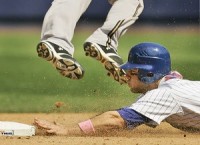
In 1987, Howard Johnson and Darryl Strawberry became the first Mets to have a 30-30 season. HoJo would do it again in 1989 and 1991. The Mets would not have another 30-30 season for another 16 years when HoJo was the Mets hitting coach.
In 2007, under HoJo’s tutelage, David Wright joined the 30-30 club. Since that time, the Mets organization once again has had a drought. Over the past nine years, the Mets have not had a 30-30 season. It’s not that surprising.
What is surprising is that with all the young exciting talent in baseball, the sport is in the middle of a drought of 30-30 players. As Andrew Simons reports on MLB.com, baseball is in the midst of a drought of 30-30 players. Since the aforementioned 1987 season, there was a 30-30 player every year until 2012. Baseball has not seen one since.
Looking at the Mets roster, Wright is the only player who has had a 30-30 season. Looking over the Mets roster, Wright is the only player that has had a 30+ homerun season and a 30+ stolen base season. He hasn’t had a 30 homerun season since 2008. He hasn’t had a 30 stolen base season since 2007. With his back, no one should anticipate Wright accomplishing either of those tasks let alone both in one season. Overall, if baseball is going to have a 30-30 player this year, it’s not going to come from the Mets.
That’s fine. It’s a statistical anomaly that has little correlation to successful teams. As we see with 1987, 1989, 1991, and 2007, those 30-30 seasons did not lead to playoff berths. Seeing a player accomplish a 30-30 season is fun, but it’s not as fun as a playoff berth.


